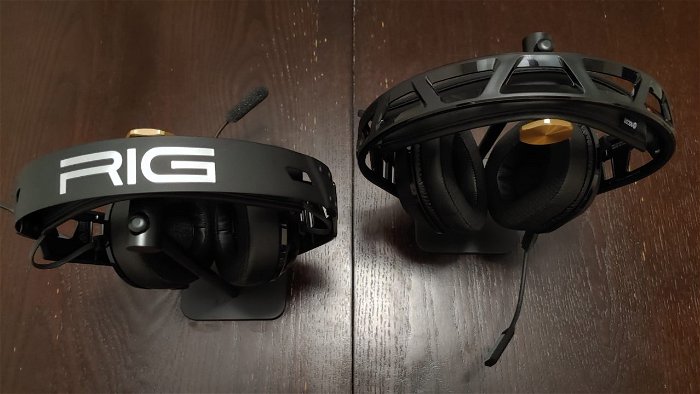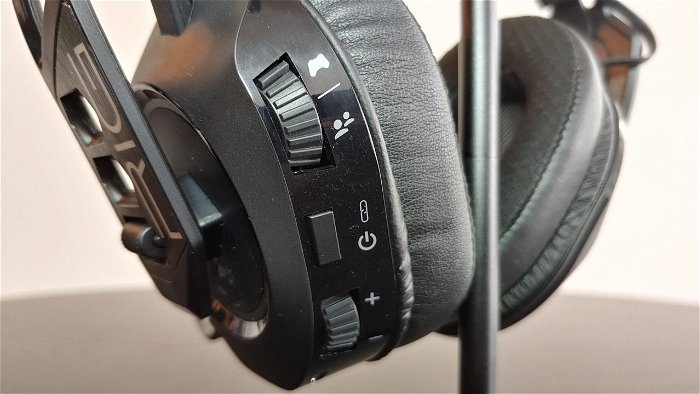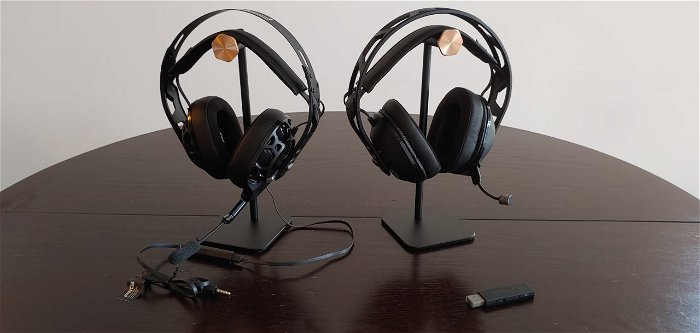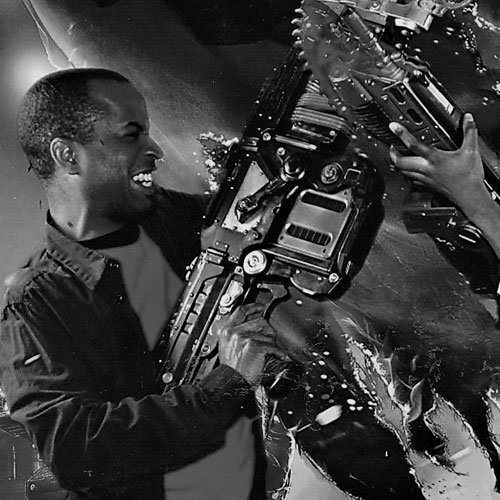We were recently presented with a conundrum here at CGMagazine. Leading game developer and peripheral manufacturer NACON provided us with two of their newest “Designed for Xbox” competition-grade, 3D Surround headsets for analysis, the wired RIG 500 Pro HX and the wireless RIG 700 Pro HX for Xbox One, Xbox Series X|S and PC. Gamers who have been following the RIG line of products will recall that RIG was recently acquired by NACON in 2020 from Plantronics (which is now largely known as Poly), and that RIG’s street cred in the professional eSports scene stretches as far back as 2012, so when this new pair of headsets we knew that NACON and RIG weren’t messing around.
As it turns out, we found both the RIG 500 Pro HX (Generation 2) and 700 Pro HX are exceptional sibling products that are so close in quality and features that it made more sense to focus on how these products compare with one another as opposed writing our traditional style of review, especially since bespoke Xbox headsets of RIGs caliber are still relatively scarce in the wild (though we will still touch upon a few of those). Anyway, the most pressing question that we knew we had to answer right away is: Between these two RIG headsets, which one is the definitive headset to own? Well, I’ve spent the past couple of weeks with both of them, and I’m happily ready to share my findings.

Comfort and Stability
First off, it goes without saying that a gaming headset built for competition needs to be lightweight and comfortable over long play sessions, and the RIG 500 Pro HX and 700 Pro HX tick both of those boxes effortlessly. Coming in at 281 and 241 grams respectively, these headsets feel almost weightless compared to other premium Xbox headsets in their category. Regarding comfort, both headsets feature a supporting head-strap that rests gently on the skull and a durable headband that provides adequate-enough clamping force to keep the ear cups from slipping off during sudden movements. In addition, the ear-cushions for both models are a combination of pleather on the exterior and a breathable air-weave fabric mesh on the inside, allowing for a bit of more air flow and making long playing sessions considerably less hot and sweaty for one’s ears (a much-appreciated feature now that summer is upon us).
The secure fit came as quite a surprise to me since unlike other gaming headsets I’ve used, the 500 and 700 don’t use a traditional headband notch system for adjusting head size. Instead, each ear cup features a large cylindrical peg that can be snapped in and out of one of three identically shaped slots on its respective side of the headband, which in turn accommodate three different head sizes, small to large. Looking at it makes It seem like it shouldn’t work so well, but it does, with both headsets staying firmly on my rather large dome without exerting excessive pressure, or alternatively, feeling too loose.
The 500 and 700 are so close to one another in this category that if not for the former headset’s audio cable I doubt I could tell any difference in feel or comfort between them if I was blindfolded. Definitely a draw here.
Comfort and Stability WINNER: DRAW

Design and Ergonomics
I have to say that I’ve quickly grown fond of the 500 and 700’s aesthetic design, which actually runs counter to my personal preference for smooth lines, clean surfaces and compactness in form factor. The 500 and 700 are about angles, rhomboid holes, and overall visual choices that take pride in the product’s edgy, gamer-centric street-cred. Case in point, the receiver on the 700 model’s boom mic is also rhomboid in shape, with the RIG logo prominently etched in its plastic mic-hood shielding. Furthermore, in all the marketing for these products, NACON touts its RIG headsets as being designed for competitive gaming, and these Pro HX models are undoubtedly targeted towards that demographic in terms of their visual presence.
What’s puzzling to me however are a couple of differences that exist between these models despite their being direct siblings of each other. Take for instance their detachable microphones. On the 500, which is an exclusively wired headset, the boom mic is not only bendable enough to be put in just about any position and hold its shape, it can also be flipped up to mute the wearer’s mic, similar to what recent entries in the Turtle Beach “Stealth” line of headsets have been doing for years. But with the 700 Pro, which is the more expensive, premium product, the bendable boom mic is far more resistant and tends to migrate back to its previous position, requiring a bit more fussing on the part of the wearer in order to get it into a position that works for them. Strangely, the boom mic can’t be flipped up either, and muting the mic can only be achieved via the shallow and rather difficult-to-locate mute button on the bottom of the left ear cup. It just seems odd that such convenient and intuitive features such as “flip to mute” and a more pliable boom mic are available on the cheaper variant of RIG’s headset but are not being echoed on the more expensive product, especially when other competing brands like Turtle Beach tend to carry those features forward. There are other questionable differences too, largely focused around the finish and materials used, such as why NACON chose to go with a plastic headband on the 700 Pro and a metal headband on the less-expensive 500 Pro, but none of them are so drastic that they are worth writing home about.
Ergonomically, the 500 easily outshines the 700 thanks to its pure simplicity. With the “flip to mute” boom mic taking the place of a dedicated button and an in-line volume rocker on the headset’s 1.3m cable, there are virtually no buttons to speak of on the headset itself. This means users won’t be struggling to find any unseen dials or other doodads while they’re in the middle of a game. The downside is that players will have to manage their chat versus game audio mix via the Xbox Guide, which depending on the kind of player you are might be a bit of a pain, but this shouldn’t be an issue for most eSports players or those who are more likely to “set it once and forget it”.
By comparison, the 700 Pro’s controls all reside on the left ear cup and are a bit trickier to find when the device is worn on one’s head, as they are widely spaced apart. Thankfully, the power button sits in shallow relief against the surrounding surface (unlike the previously mentioned mute button) and can be used for reference to find the chat/game balance and volume dials, which are positioned above and below correspondingly. The dials have a nice, tactile resistance to them, allowing for a smooth and gradual increase or decrease in values and a far smaller likelihood of accidentally damaging one’s hearing by spinning either of them up too fast. As you might have guessed, the Mute button is certainly the biggest offender of the four controls, running nearly flush to the bottom of the ear cup and is thus hard to locate. Also, the only way to know if the mic is muted or not is to press the mute button and listen for an up-pitched or down-pitched tone. An up-pitch means the mic is live, a down-pitch means the mic is muted. Sadly, there is no LED light indicator on the boom mic to confirm that the mic is active.
Taking all of this into consideration, it’s a point on the board for the 500 Pro.
Design and Ergonomics WINNER: NACON RIG 500 Pro HX

3D Audio
Now the time has come to address the most important feature (at least in my book) and boldest claim of both these headsets, which is support for 3D Audio, powered by Dolby Atmos for Headphones technology. These words can be found plastered all over the retail packaging in several places, and NACON is so confident in both headsets that they have included access to the required Dolby Atmos app for free in the box. The 500 comes packaged with a 2-year activation code, while the 700 automatically provides licensed access to the app once its 3D dongle is attached to the console. To be honest, before starting this comparison I was most curious about NACON’s claim surrounding the 500 Pro in particular, which boasts “Competition Grade 3D Audio”. Personally speaking, all my previous experiences of using Dolby Atmos for Headphones with a wired headset up to that point had been consistently disappointing, and almost indistinguishable from plain stereo in fact. The marketing for the RIG 500 Pro HX is the first I’ve seen that has actually used the words “3D Audio” for a wired headset, so despite feeling rather skeptical I went into this review with a little hope, given that NACON was willing to put RIG’s reputation on the line. So you can imagine my pleasant surprise when the 500 ended up being not too shabby!
I spent about a week only using the 500 Pro before moving on to the 700 Pro, and when compared to my regular go-to headsets (the Xbox Wireless Headset and the Turtle Beach Stealth 700 Gen 2, both wireless headsets, mind), the 500 Pro provides “satisfactory” 3D surround performance. I put the headset through the paces with several games, including Gears 5, MechWarrior 5: Mercenaries, Resident Evil 7 and more, as well as one of my fave audio test Blu-Rays, Hellboy 2: The Golden Army, and found the headset to be an adequate substitute to my wireless cans in a pinch. I’ll be honest: In terms of impressive surround sound, the 500 Pro is almost there, but not quite, falling noticeably below the easily distinguishable surround sound effects of the Turtle Beach Stealth 700 and 600 Gen 2 headsets, the Xbox Wireless Headset, and to a lesser but still perceptible extent its sibling the 700 Pro, specifically in that order.
All that being said, practically all 3D surround sound in today’s gaming headsets is simulated, and the 500’s implementation is still the best I’ve yet to experience in a wired product. It’s not nuanced enough during Gears 5’s campaign to tell the player exactly where an off-screen character who is talking is standing behind them, or sell the illusion that the sounds of creaking support beams that one hears while lurking through Azura’s missile silos are coming from directly overhead, but in the game’s versus multiplayer I had absolutely no problems discerning the location of enemies bearing down on me, especially when a quick-footed locust drone or COG soldier was in close pursuit behind me during a roadie run. Such no-nonsense accuracy is crucial when one is reminded of the product’s intended audience: competitive gamers. In this light the RIG 500 Pro HX shines brightest, dispensing of any unnecessary bells and whistles and focusing on reliable, uninterrupted play.
Looking beyond multiplayer and competitive play though, it’s all about the 700 Pro. As I briefly teased earlier, the RIG 700 Pro HX lives up to its promise of delivering convincing wireless 3D surround that is inarguably a step above anything the 500 Pro can offer via its wired connection. My own ears rank the 700’s surround capabilities as just a smidge below the Xbox Wireless Headset and the Turtle Beach Stealth 600 Gen 2, which in turn are both slightly bested by the Turtle Beach’s Stealth 700 Gen 2 thanks in no small part to its more powerful 50mm drivers, but these four headsets are still close enough to one another that I could see why a less-discerning gamer might consider the whole thing a wash. When put up against the 500 Pro however, the 700 Pro’s superior 3D surround fidelity is unmistakable, especially when playing games such as Gears 5 which are built to exploit the subtleties of the technology with their rich, varied environments and diverse soundscapes. There’s not much else to say here; while the 500 Pro makes a valiant 3D audio effort, this is an easy lay-up point for the 700 Pro.
3D Audio WINNER: NACON RIG 700 Pro HX

Quality of Life Features vs Pet Peeves
This comparison point is tricky because wired and wireless headsets inevitably come with unavoidable pros and cons, and the 500 Pro comes out looking better here just by nature of offering fewer features. It’s wired, so there’s no battery that needs recharging, and no wireless connection that could potentially drop in the middle of a match (unless there’s a problem with the controller that the headset is attached to). Even the rather long, in-line volume rocker on the headset’s audio cable “soft locks” in the max volume position so users can choose to set it and forget it, which is a thoughtful feature. Plus, the headset offers rock solid bass response, zero distortion, and according to my trusted online wingman (my brother), a clean, crisp mic signal, though the 700 Pro has no issues in those areas either. Frankly, the only genuine complaint I can level towards the 500 Pro in this category is the length of the audio cable, which in my opinion is too short at 1.2 metres for a headset that is also PC compatible. A little extra slack would have gone a long way to make this headset more comfortable to use with a laptop, or possibly even a desktop depending on how close one sits in relation to their computer. In the cable’s defense however, it seems to be just the right length for use with a tablet or smartphone, and better yet it’s the flat, tangle-resistant variety.
As for the 700 Pro…well, there’s just no getting around talking about that proprietary dongle. In order to achieve wireless connectivity of up to 30 feet, the RIG 700 Pro HX uses a wireless USB dongle that measures over 2 inches in length. It protrudes awkwardly from the front of any Xbox and is even more unsightly sticking out of the side of a laptop, potentially taking up valuable real-estate if your console or PC occupies a compact space. On the bright side though, the 700 Pro boasts 18 hours of battery life, and I can personally attest that it took me over a week of using the headset for up to two hours every night before I finally drained the headset’s initial out-of-box charge and had to recharge it. It bears repeating that RIG products are aimed at competitive gamers, so this is one area that the 700 Pro definitely has an edge. It doesn’t quite make up for the lack of other features offered by competing headsets in the same or lower price range, such as the Turtle Beach Stealth 600 Gen 2’s flip-to-mute mic and “Superhuman Hearing” features, or the Xbox Wireless Headset’s LED mic-light and simultaneous Bluetooth connectivity with other devices such as smartphones, but it’s definitely something. In the end though I have to give this point to the 500 Pro, not only for the speed in which players can simply plug it into their controller and go (the 700 Pro requires an abnormally long press of the power button to wake up) but also the fact that the controller doesn’t tie up a valuable USB port, which are always at a premium on Xbox consoles. Plus, no one has to stare at that ridiculously huge dongle.
Quality of Life Features vs Pet Peeves WINNER: NACON RIG 500 Pro HX

Value vs. the Competition
As of this writing the MSRP for the RIG 500 Pro HX (also known as the 500 Pro HC) and RIG 700 Pro HX are $69.99 USD (approx. $85 CAD) and $119.99 USD (approx. $145 CAD) respectively. It should be noted that the RIG 700 HX is a GameStop USA exclusive. While the 500 Pro falls into a reasonable price bracket for what it offers as 3D audio-capable, competition-grade wired headset, the 700 Pro’s price tag is a little harder to justify when compared the previously mentioned rival headsets from Microsoft and Turtle Beach, which offer more features at a lower price. Mind you, the price difference isn’t huge. We’re talking a difference of around $5-15 CAD based on the above guesswork with exchange rates, so gamers that value eSports-level reliability and exceptional battery life over bells and whistles like Bluetooth and LED indicators are hardly being punished for going with the 700 Pro. In fact, I’d argue that most competitive gamers consider such a difference negligible at worst. But while I can appreciate the concept of “less is more” when it comes to design, in my book, more features at a lower price is always the better option, which makes the 700 Pro’s pricing a bit difficult to swallow considering what else is out there. It’s subjective, but I gotta give it to the 500 Pro.
Value vs. the Competition WINNER: NACON RIG 500 Pro HX

So, there you have it, a gamer who swears by wireless surround sound and hates wires in just about all forms is telling you that the NACON RIG 500 Pro HX wired headset is the RIG headset to own, even when compared to its more powerful, 3D audio-performant sibling. Definitely ironic, but I have to give credit where credit is due. The 500 Pro delivers reliable, consistent performance for competitive types while also offering adequate, simulated surround that doesn’t get in the way of the basics, which pro gamers are bound to appreciate. It also doesn’t charge too much for it either, making the 500 Pro it an easy choice for those looking for a headset that prioritizes eSports functionality. That said, if you are looking for all the above plus freedom from wires and more convincing 3D surround when playing less-competitive and immersive types of games, then without question the NACON RIG 700 Pro HX is the headset you should consider picking up.




